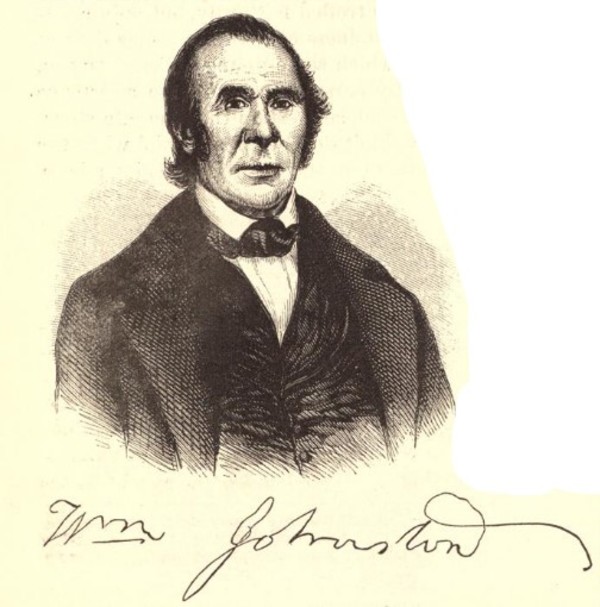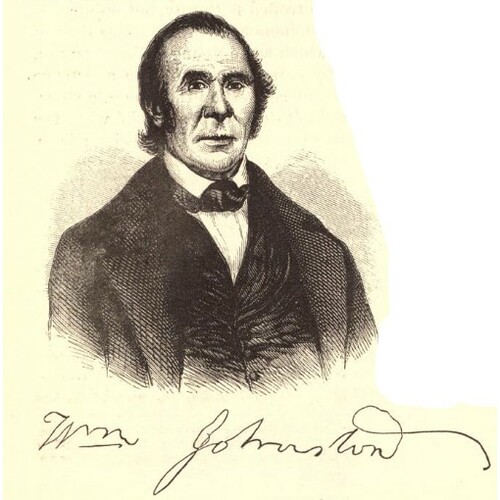
Source: Link
JOHNSTON, WILLIAM, agitator and pirate; b. at Trois-Rivières, Province of Quebec, 1 Feb. 1782, the son of loyalist James Johnston, a sergeant in Edward Jessup*’s corps of loyalist rangers; d. 17 Feb. 1870 at Clayton, N.Y.
Although his formal education was limited, “Bill” Johnston learned blacksmithing and boat building as a youth in Ernestown Township, Upper Canada, and in the years 1804–13 operated first a lake freighting business and then a store in Kingston. In 1810 he married an American citizen of Washington County, N.Y., Anna Randolph, a step which he later described as being the root of his troubles. He served in 1812 as a private in the 1st Regiment of Frontenac militia but in 1813 was imprisoned at Kingston on suspicion of being an American agent in communication with Commodore Isaac Chauncey’s fleet; Johnston always denied the charge. He escaped from prison and defected to the American forces, leaving behind, by his own account, property to the value of $20,000. His role during the remainder of the war is obscure, but it certainly included spying and making small raids on British shipments of supplies and mail. He afterwards claimed to have personally known and to have earned the gratitude of both Chauncey and General Jacob Brown.
During the 1820s and 1830s Johnston acquired a reputation as a smuggler operating between French Creek (Clayton), N.Y., and the Kingston area. In this period several of his relatives in Upper Canada were subjected to harassment because of alleged contacts with “the notorious traitor and pirate William Johnston.”
When William Lyon Mackenzie fled to Buffalo, N.Y., in mid December 1837, Johnston offered his services to the Patriot cause. He was briefly on Navy Island, Mackenzie’s headquarters, and there received a Patriot “naval commission.” On 22 Feb. 1838 he was one of the leaders, along with Rensselaer Van Rensselaer, of the abortive Hickory Island raid, near Gananoque. After this failure he began a series of independent border raids with a small number of followers from a secret base in the Thousand Islands, his most notorious exploit being the capture of the Canadian passenger steamship Sir Robert Peel at Wells Island (Wellesley Island) on the night of 29–30 May 1838. He planned to use the captured ship as a pirate vessel with which to seize other British lake steamers, but a lack of manpower (he had only 13 men) made this plan impossible and the Sir Robert Peel was burned in American waters after being looted. Rewards for his capture, £1000 by Lord Durham [Lambton*] and $500 by the governor of New York, were then offered.
On 10 June 1838 Johnston issued a proclamation as “Commander-in-Chief of the naval forces and flotilla,” declaring that he led a movement for “the independence of the Canadas.” During the summer of 1838 he continued to make periodic raids on shipping and property, although he was continually pursued by both British and American forces. He attended the convention of the secret Hunters’ Lodges in Cleveland in September 1838, where he was given the title “Commodore of the Lower division on Lake Ontario”; as such he played a role in preparations for the American raid led by Nils von Schoultz* on Prescott (the battle of the Windmill) in November 1838. During the battle he ran his ship aground, never reached the Canadian shore, and earned the ire of the Patriot Hunters stranded without reinforcements or supplies. He then surrendered to American authorities – “the weather growing cold.” Released on bail early in 1839 he resumed, on a reduced scale, his hit-and-run incursions from the Thousand Islands. After he was finally captured in the winter of 1839, he was sentenced in February 1840 to jail in Albany for one year but escaped in May. He was never recaptured and ultimately received a federal pardon, but in any case by the time of his escape the Patriot movement as a whole had virtually ceased to exist. He spent the rest of his life in the area of Clayton, where his six children and his brother John also settled. He was appointed lighthouse keeper on Rock Island and then was tavern keeper at Clayton.
Bill Johnston’s contemporaries on both sides of the border agreed that he possessed extraordinary courage, strength, and resourcefulness; but he was also uncouth, a braggart, and of dubious honesty. Because of his unsavoury reputation it has generally been supposed by Canadian historians that he was simply a criminal whose piratical activities were undertaken for his own enrichment, yet his numerous letters to Mackenzie from 1837 to 1840 strongly suggest a higher motive. He was a convinced republican who believed sincerely in a government and a society more democratic than those he had left in Upper Canada. He was not, however, in any sense a revolutionary. He had no faith in a spontaneous Canadian uprising. In American terms his political views were conservative. In the 1830s and 1840s he consistently supported the Whig party of Henry Clay and William Harrison against the Democrats of Martin Van Buren. His motives for joining the Patriot movement were straightforward: in his own words he wished to “drive the two countries at it” in the hope of an American victory, or, failing this, to create as great a financial drain on the British Treasury as possible. Though he too finally became disillusioned with the struggle to liberate the Canadas, he was true to the cause longer than most of the other border agitators. “You can depend upon me to stick to the Patriot cause as long as I have breath,” he told Mackenzie in March 1840. “I don’t go to sleep as many of our pretended friends do.”
PAC, MG 24, C10; RG 5, A1, 195, 203, 208, 223; B41, 4; RG 7, G6, 4; G9A, 3–5, 7–9; RG 8, I (C series), 608–14, 1274, 1717; RG 9, I, B1, 16–18, 20, 23–24, 31, 34–36, 39. PAO, Mackenzie-Lindsey papers. PRO, CO 42/280, 42/282, 42/285–86, 42/290, 42/297, 42/300, 42/445, 42/451, 42/459, 42/461, 42/463.
Revisions based on:
William Gates, Recollections of life in Van Dieman’s Land (Lockport, N.Y., 1850). D. E. Graves et al., Guns across the river: the battle of the Windmill, 1838 (Montreal, 2013). K. F. Scott, Prescott’s famous battle of the Windmill, November 13–18, 1838 ([Prescott, Ont., 1970]).
Cite This Article
J. K. Johnson, “JOHNSTON, WILLIAM (1782-1870),” in Dictionary of Canadian Biography, vol. 9, University of Toronto/Université Laval, 2003–, accessed April 15, 2025, https://www.biographi.ca/en/bio/johnston_william_1782_1870_9E.html.
The citation above shows the format for footnotes and endnotes according to the Chicago manual of style (16th edition). Information to be used in other citation formats:
| Permalink: | https://www.biographi.ca/en/bio/johnston_william_1782_1870_9E.html |
| Author of Article: | J. K. Johnson |
| Title of Article: | JOHNSTON, WILLIAM (1782-1870) |
| Publication Name: | Dictionary of Canadian Biography, vol. 9 |
| Publisher: | University of Toronto/Université Laval |
| Year of publication: | 1976 |
| Year of revision: | 2020 |
| Access Date: | April 15, 2025 |



